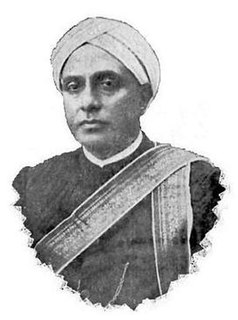
Presidency College is an arts, law and science college in the city of Chennai in Tamil Nadu, India. Established as the Madras Preparatory School on 16 October 1840 and later, upgraded to a high school and then, graduate college, the Presidency College is one of the oldest government arts colleges in India. It is one of the two Presidency colleges established by the British in India, the other being the Presidency College, Kolkata.

SachivottamaSir Chetpat Pattabhiraman Ramaswami Iyer, KCSI, KCIE, also called "C. P.", was an Indian lawyer, administrator and politician who served as the Advocate-General of Madras Presidency from 1920 to 1923, Law member of the Executive council of the Governor of Madras from 1923 to 1928, Law member of the Executive Council of the Viceroy of India from 1931 to 1936 and the Diwan of Travancore from 1936 to 1947. Ramaswami Iyer was born in 1879 in Madras city and studied at Wesley College High School and Presidency College, Madras before qualifying as a lawyer from the Madras Law College. He practised as a lawyer in Madras and succeeded S. Srinivasa Iyengar as the Advocate-General of the Madras Presidency. He subsequently served as the Law member of the Governor of Madras and of the Viceroy of India before being appointed Diwan of Travancore in 1936.

Raja Sir Panaganti Ramarayaningar KCIE, also known as the Raja of Panagal, was a zamindar of Kalahasti, a Justice Party leader and the Chief Minister or Premier of Madras Presidency from 11 July 1921 to 3 December 1926.

Sir Pazhamaneri Sundaram Sivaswami Iyer was a prominent lawyer, administrator and statesman who served as the Advocate General of Madras from 1907 to 1911.

Subramaniya Siva was an Indian writer and activist during the Indian independence movement.
Sir Panapakkam Anandacharlu CIE (1843–1908) was an Indian advocate, freedom fighter and one of the early doyens of the Indian National Congress. He was the President of the Nagpur session of the Indian National Congress held in 1891.

Sirkazhi Govindarajan was a leading vocalist in Carnatic Music.

Sir Thiruvarur Muthuswamy Iyer was an Indian lawyer who, in 1877, became the first native Indian to be appointed as judge of the Madras High Court. He also acted as the Chief Justice of the Madras High Court in 1893. He is also one of the first Indians to have a statue.
Rao Bahadur Mylai Chinna Thambi Pillai Rajah was a Tamil politician, social and political activist from the Indian state of Tamil Nadu. He was born into Paraiyar caste, which is a Scheduled Caste.
Diwan Bahadur Cozhisseri Karunakara Menon (1863–1922) was an Indian journalist and politician from the erstwhile Madras Presidency. He was the second editor of The Hindu after G. Subramania Iyer and the founder of the Indian Patriot.

Rao Bahadur S. A. Saminatha Iyer, also known as Thanjavur Saminatha Iyer, was an Indian lawyer, landlord, politician and theosophist who served as Chairman of the Tanjore municipality and a delegate to the 1885, 1886, 1887, 1889 and 1894 sessions of the Indian National Congress. He spoke against salt tax in the first session conducted in 1885 and in 1887, was a part of a 32-member team that wrote the constitution of the Congress. Christopher Baker and D. A. Washbrook describe him as the "most celebrated spokesman of the Tanjore gentry".
E. Krishna Iyer was an Indian lawyer, freedom-fighter, classical artist and activist who was responsible for popularizing the dying art of Bharatanatyam in South India.

A. Vaidyanatha Iyer (1890–1955), also known as Madurai Vaidyanatha Iyer or Ayyar was an Indian activist, politician and freedom-fighter who spearheaded the temple entry movement in Madras Presidency in 1939.

Diwan Bahadur V. S. Subrahmanya Iyer was an Indian administrator who served as the Diwan of the princely state of Travancore from 1929 to 1932.
Pennathur Subramania Iyer (1860–1901) was an Indian lawyer and philanthropist who is best known as the founder of the P. S. Charities.

Raja Sir Muttaiya Annamalai Muthiah Chettiar was an Indian banker, politician, philanthropist, socialite and cultural activist who served as Mayor of Madras city (1933) and Minister of Excise and Education (1936–37) in the provincial government of Madras Presidency. He was holder of the hereditary title Kumar-rajah (1929–48) and later, Raja of Chettinad (1948–84).
General elections were held in British India in September 1930. They were boycotted by the Indian National Congress and marked by public apathy. The newly elected Central Legislative Assembly met for the first time on 14 January 1931.
The Advocate-General of Madras was charged with advising the Government of the British administered Madras Presidency on legal matters. The Presidency existed from 1652 to 1950. Prior to 1858, when it was administered by the East India Company, the Advocate-General was the senior law officer of that company and also the Attorney-General of the Sovereign of Great Britain and an ex-officio member of the Madras Legislative Council.
Dravidian movement started with the formation of the Justice Party on November 20, 1916 in Victoria Memorial Hall in Madras by T. M. Nair and P. Theagaraya Chetty as a result of a series of non-Brahmin conferences and meetings in the presidency. Communal division between Brahmins and non-Brahmins began in the presidency during the late-19th and early-20th century, mainly due to caste prejudices and disproportionate Brahminical representation in government jobs. The Justice Party's foundation marked the culmination of several efforts to establish an organisation to represent the non-Brahmins in Madras Presidency.












